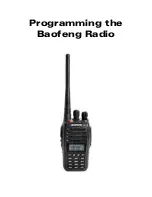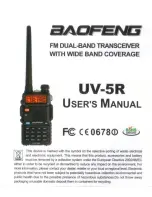
1-14
1-60.
Comparators U66A/U66B operate in association to monitor high forward power
conditions. U66A/U66B use the high reflected power attack circuitry to reduce the
transmitter power when a high forward power condition occurs. When the transmitter
power is greater than 90%, U66B will output a HIGH. When a high forward power
conditions results in the forward power sample to increase above the voltage reference by
approximately 20%, the output of U66A will go HIGH. The HIGH is applied to AND gate
U47B. With a HIGH from U66B, U47B will output a HIGH to OR gate U62A. U62A will
output a HIGH to AND gate U47A. With a HIGH enable failure signal, U47A will output:
1) a HIGH reflected power high attack signal to priority encoder U28 and 2) a HIGH to
latch U67A. The HIGH reflected power attack signal is used by U28 to initiate an attack
sequence to reduce the transmitter output power. The HIGH to U67A will configure
U67A to output a HIGH reflected power signal to enable latch U48D. U48D will output a
HIGH to bias: 1) alarm status indicator driver transistors Q34 and Q35 on and
2) antenna indicator driver Q28 on. When the transmitter power is reduced to
approximately 90%, the output of U66B will go LOW. The LOW is applied to U47B.
U47B will output a LOW through U62A to U47A. U47A will respond by routing a LOW to
terminate the high reflected power attack signal. The indicators will remain illuminated
until the alarm reset switch is depressed.
1-61.
High Reflected Power Circuitry.
Integrated circuit U65C monitors reflected power
conditions. U65C compares a reflected power sample from U64C to a voltage reference.
When the reflected power sample increases above the voltage reference, the output of
U65C will go HIGH. The HIGH is applied through OR gate U62A to AND gate U47A.
With a HIGH enable failure signal, U47A will output: 1) a HIGH reflected power high
attack signal to priority encoder U28 and 2) a HIGH to latch U67A. The HIGH reflected
power attack signal is used by U28 to initiate an attack sequence to reduce the
transmitter output power. The HIGH to U67A will configure U67A to output a HIGH
reflected power signal to enable latch U48D. U48D will output a to HIGH to bias:
1) alarm status indicator driver transistors Q34 and Q35 on and 2) antenna mismatch
indicator driver Q28 on.
1-62.
Over-temperature Circuitry.
Over-temperature conditions are monitored by an
over-temperature fault detection circuit. A dc voltage representing the transmitter
temperature is applied to: 1) integrated circuits U65A/U65B and 2) integrated circuit
U61A. When the temperature voltage increase above a reference voltage, the output of
U65A will go HIGH. The HIGH is routed to AND gate U51D. With a HIGH enable
failure signal, U51D will output: 1) a HIGH over-temperature attack signal to priority
encoder U28 and 2) a HIGH to latch U67C. The HIGH over temperature attack signal is
used by U28 to initiate an attack sequence to reduce the transmitter output power. The
HIGH to U67C will configure U67C to output a HIGH: 1) over-temperature signal to
latch U49B and 2) to AND gate U47D. The output of U49B will go HIGH to bias:
1) alarm status indicator driver transistors Q34 and Q35 on and 2) over-temperature
indicator drivers Q32 and Q36 on. When the transmitter temperature is reduced to 70
degrees C, the output of U65A will go LOW and the output of U65B will go HIGH. The
LOW is applied to U51D. U51D will output a LOW to terminate the over-temperature
attack signal. The indicators will remain illuminated until the alarm reset switch is
depressed. The from HIGH from U65B is also applied to U47D. With the HIGH from
U67C, U47D will output a over temperature release signal to encoder U28.
1-63.
U61A is configured as a comparator designed to monitor extreme temperature conditions.
When the temperature voltage increases above the reference voltage, the output of U61A
will go HIGH. U61A will output a HIGH temperature shutdown command to U13A of the
transmitter off control circuit.
Summary of Contents for AM-2.5E
Page 11: ...1 2 FIGURE 1 1 AM 2 5E TRANSMITTER 597 1114 1 COPYRIGHT 1999 BROADCAST ELECTRONICS INC...
Page 12: ...1 3 COPYRIGHT 1999 BROADCAST ELECTRONICS INC 597 1114 2 FIGURE 1 2 AM 5E TRANSMITTER...
Page 40: ...2 24 FIGURE 2 11 AM 5E PRIMARY AC WIRING COPYRIGHT 1999 BROADCAST ELECTRONICS INC 597 1114 9...
Page 68: ...597 1114 5 FIGURE 4 1 AM 2 5E BLOCK DIAGRAM 4 3 4 4 COPYRIGHT 1999 BROADCAST ELECTRONICS INC...
Page 69: ...597 1114 4 FIGURE 4 2 AM 5E BLOCK DIAGRAM 4 5 4 6 COPYRIGHT 1999 BROADCAST ELECTRONICS INC...
Page 121: ......
Page 122: ......
Page 123: ......
Page 124: ......
Page 125: ......
Page 126: ......
Page 127: ......
Page 128: ......
Page 129: ......
Page 130: ......
Page 131: ......
Page 132: ......
Page 133: ......
Page 134: ......
Page 135: ......
Page 136: ......
Page 137: ......
Page 160: ......
Page 161: ......
Page 162: ......
Page 163: ......
Page 164: ......
Page 188: ......
Page 189: ......
Page 190: ......
Page 191: ......
Page 208: ......
Page 209: ......
Page 210: ......
Page 211: ......
Page 291: ......
Page 292: ......
Page 293: ......
Page 294: ......
Page 295: ......
Page 296: ......
Page 299: ......
Page 300: ......
Page 301: ......
Page 302: ......
Page 303: ......
Page 304: ......
Page 305: ......
Page 306: ......
Page 309: ......
Page 310: ......
Page 311: ......
Page 312: ......
Page 313: ......
Page 314: ......
Page 317: ......
Page 318: ......
Page 319: ......
Page 320: ......
















































